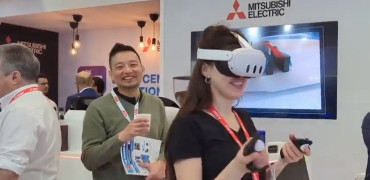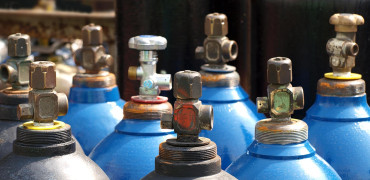I’ve written before about the virtual reality (VR) training that we recently introduced as a way of helping HVAC engineers to understand how our larger equipment works.
And now, we’re using this ‘gamification’ of our equipment to reach out to a generation brought up on immersive gaming.
VR allows you to explore inside the world of HVAC, and literally ‘see’ the internal workings and components of chillers, heat pumps and larger equipment.
We are now taking our VR package out on the road, where we aim to help show students and school leavers how they can join the renewable future by training as an HVAC engineer.
We developed the system so that you can ‘go inside’ our equipment and study each component and gain a much better understanding of how they work, how they can be commissioned and where to look if something is not working as it should be.
The VR system allows us to create ‘dangerous situations’ for engineers to overcome
Always improving
We’ve already won awards for the work we did redesigning our training after the pandemic, when we realised that we could make training easier for engineers and reach far more, if we developed online learning that allowed people to choose when to do it.
But we are never one to stand still or rest on our laurels, so me and my colleagues have built this to develop a new way of introducing larger products to engineers.
The virtual reality tool brings larger equipment to engineers and allows them to go inside the unit to show the various components such as the compressor, the circuit boards, the expansion valves and chamber, etc.
This enables the people installing, commissioning and maintaining these sophisticated pieces of equipment to gain a clear understanding of how they work.
They can do this online or using our virtual reality headsets in our training facilities.
We also realised that we could take this exciting new development out into the wider arena and use it at educational events to target the engineers of tomorrow – Something the industry must achieve if we are to recruit the skilled engineers we need to help us achieve net zero.
Click on this link for an idea of how the system works and to see a virtual tour of our Hatfield Showroom and the equipment in it.
Creating danger
The VR system has real benefits for training because, in addition to gamifying the learning experience, it allows us to create virtual ‘dangerous situations’ that engineers will need to navigate around with equipment, including health and safety issues, which increases the training but limits the risks
So far, we have filmed virtual tours of the insides our commercial CAHV air source heat pump and residential ecodan heat pump, along with our MEWall IT Cooling system, and our unique Hybrid VRF air conditioning.
Each of the films allows us to focus on individual components within the products, so anyone can look at the footage and navigate their way around the entire system, pausing for useful information along the way.
And we’re not stopping there as we will look at all the myriad of other equipment that we can’t quite squeeze into our training suites, such as other chillers, air handling units, more ground and air source heat pumps, our Lossnay ventilation systems, other IT Cooling systems and our new refrigeration units.
The added benefit of the gamification of HVAC is that it is reaches out to students and other young people in a way that they can engage with, so that we can encourage more ‘new blood’ into our industry and begin to tackle the skills gap and shortage of qualified engineers.
Ben Bartle-Ross is a Technical Trainer




